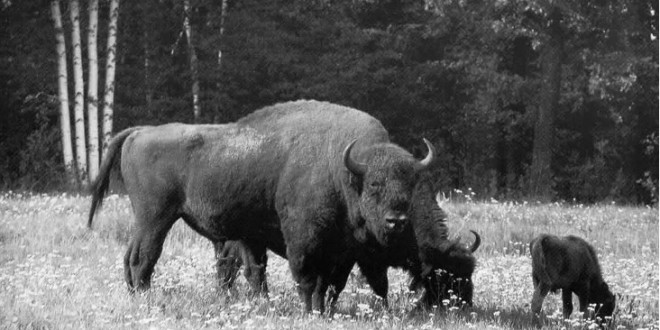By: William J. Morrison
THE NOBLE BEASTS OF THE LITHUANIA
In 1517 Maciej from Miechow, Master of the Krakow Academy included the following in a description h of the Grand Duchy of Lithuania:
“There are large territories covered with primeval forest, completely unpopulated, spreading for 10,15 and 25 miles. Only the boundaries of the forest are inhabited. The forest is populated with many wild animals. There are forest oxen, called in the language of Lithuania tury and zumbrony…”
It was with quite the same attempt to inspire awe that my maternal grandmother used to describe the landscapes near her native village in the county of Taurage, Kaunas Gubernija in the last quarter of the 19th Century: “Rich people owned forests that went for miles, miles…” Maciej was describing not just ethnographic Lithuania, but the Grand Duchy in general in which, at that time, the Polish language prevailed. “Tury” (singular “tur”) is Polish for wild oxen, now extinct, for which there is no special word in English; the German “aurochs,” in the singular, is generally used by English speakers. To my ears the Lithuanian “tauras” (plural “taurai”) has a more noble ring to it than those other words. Not only that, it reminds me of Grandma’s county. The name of the second wild ox, “zumbrony,” is a plural of some alternative of the Polish word “zubr” or bison. In Lithuanian it’s “stumbras.” So, the tauras and the stumbras, two different species of wild ox, the former extinct (maybe) and the latter rebounding numerically, once inhabited Lithuania’s forests. For that matter, they both inhabited much of central and southeastern Europe, but it was in certain forests of Lithuania and Poland that they held out the longest despite hunting and destruction of their habitats.
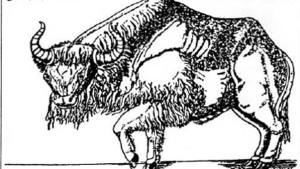
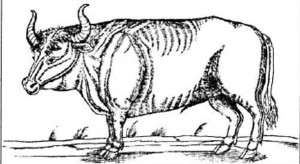
The stumbras or European bison with it’s full scientific name Bison bonasus bonasus and the tauras or wild ox (Bos primigenius) are frequently confused with one another. Not only did chroniclers of history misidentify these animals but even 18th century scientists were of two schools of thought; some refused to accept that Europe had two species of wild ox in historical times.
Sigismund von Herberstein, a diplomat representing the Habsburg imperial court in Moscow, traveled through Lithuania in 1517 and 1526. In his memoirs Herberstein states that while the bison existed in Lithuania, there were no wild oxen there. The latter, he wrote, only existed in the Jaktorow Forest in Poland. Herberstein was quite familiar with.both animals and in an attempt to clear up the confusion that existed in the West about them, he included two drawings in his memoirs. One of the drawings was of the wild ox, and in the caption written in Latin it reads “I am an urus, in Polish tur, in German aurochs. Ignorant ones call me bison.” The other drawing, that of the bison, is captioned “I am a bison, in Polish zubr, in German bisont. Ignorant ones call me aufochs.”
In the following two-part article, we’ll have a look at these two beasts and their Lithuanian connections. As we’ll see, these animals are symbols of a glorious past when men of high social status not only hunted them as an expression of their nobility, but saw to their preservation as well. The tauras and the stumbras represented royalty, power, and dominion. They are equally symbols of strength, fertility, and the survival of life itself.
PART 1 – STUMBRAS
OH GIVE ME A HOME WHERE THE BUFFALO roam…” Thus begins the popular cowboy song which uses the bison as a device to evoke an image of the American (and Canadian) west. However, few persons of Lithuanian ancestry would have visions of the ancestral homeland upon hearing that song’s first line. The fact is, they might well do so.
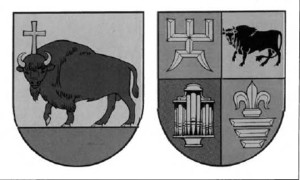
The European bison (Bison bonasus), called “stumbras” in Lithuanian, descend from bison that roamed Europe when half the continent was covered with an ice sheet. Images of these prehistoric beasts were painted on cave walls at Altamira in Spain and Lascaux in France by Paleolithic humans. Another species of bison (Bison bison) evolved in North America and differs from its European cousin in its more massive shoulders and head and generally burly physique. The European bison is a forest dweller, which seems to account for its more slender build.
With hunting and clearing of forest habitat, the European bison gradually retreated to the less disturbed parts of its range. It held its own in free-ranging populations in Lithuanian territory from prehistoric times until quite late in history. Evidence that the bison inhabited all of ethnographic Lithuania has been found by archaeologists who have unearthed its bones from fortress-hills in the districts of Alytus, Kaišiadorys, Marijampole, Rokiškis and Trakai. Place names suggest the former presence of the bison in ethnographic Lithuania, examples being the villages of Stumbrai near Mažeikiai, Stumbres just south of Rietavas, Stumbriškis southwest of Pasvalys, and Stumbragiriai in southwestern Lithuania. We should be cautious in concluding that each of these places was named from the bison that may have been present there, as some of them could have been named after a person or family. In a 1559 document describing the forests of Lithuania it is stated that bison herds existed in Augustavas and Bialovieža forests (both now in Poland) as well as in Kazlu Ruda forest (now in Lithuania).
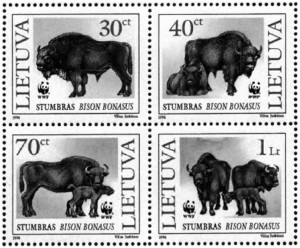
The European bison has come to be especially associated with the primeval forest of Bialovieža. Now divided between Poland and Belarus, it had been within the boundaries of the Lithuanian state since the time of the Lithuanian King Mindaugas (13th century). In even earlier times it was part of the homeland of the Sudavians, a Baltic tribe closely related to the Lithuanians. The Lithuanian language is said still to have been spoken in parts of Bialovieža until the end of the 19th century.
American author Upton Sinclair in his famous novel, The Jungle, published in 1906, fairly accurately portrayed many aspects of his numerous Lithuanian characters. Furthermore, it is remarkable that Sinclair could have known that Lithuanian speakers, like the book’s main character, Jurgis, lived in Bialovieža, which is in a region inhabited mostly by Poles and Belarussians. In describing the origin of the immigrant and Chicago stockyard worker Jurgis, Sinclair wrote:
“His father and his father’s father before him, and as many ancestors back as legend could go, has lived in that part of Lithuania known as Brelovicz [sic], the Imperial Forest. This great track of a hundred thousand acres, which from time immemorial has been a hunting preserve of the nobility. There are very few peasants settled in it, holding title from ancient times; and one of these was Antanas Rudkus, who had been reared himself, and had reared his children in turn, upon half a dozen acres of cleared land in the midst of wilderness.”
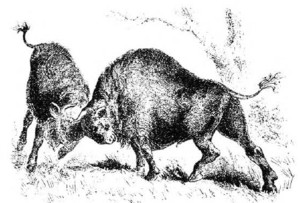
Bialovieža forest was a favorite hunting ground of Grand Duke Vytautas and the many Lithuanian, Polish, Russian, and German nobles and political leaders who followed him in the course of history. The forest and the shaggy bison that dwell there are vividly described by Simon Schama in the first chapter of his book Landscape and Memory. Schama, a historian with Lithuanian-Jewish roots, titled the chapter “In the Realm of the Lithuanian Bison.” His book eloquently develops the thesis that forests, mountains and rivers are of great mythic importance to modern western culture. Schama analyzes the meaning of the bison and the Lithuanian forest:
“…the animal was depicted as a miraculous relic of a presocial, even prehistoric past — a tribal, arboreal world of hunters and gatherers, at the same time frightening and admirable. The bison became a talisman of survival. For as long as the beast and its succoring forest habitat endured, it was implied, so would the nation’s martial vigor. Its very brutishness operated as a test of strength and justice. The animal featured in ordeals imposed by primitive courts like that of the fifteenthcentury prince of Lithuania Zygmunt (Žygimantas) the Great, who punished a criminal of his own court by dressing him in brilliant red and letting him be torn to pieces by enraged bison. And prowess in the bison hunts became woven into the legends of all those princes who had defended the marcher realm against Teutons from the west and Tartars from the east. Prince Witold (Vytautas) was said to have practiced capturing young bison single-handed as an exercise in martial preparation.”
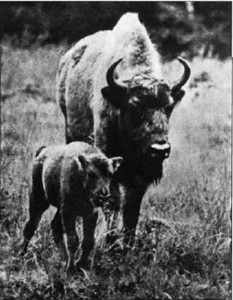
over 200 years. The first calf was born in 1971 at the Pašiliai preserve. It was named “Lieknas (“Slender”).
The Lithuanian bison played an utilitarian role in European history. In preparation for the Battle of Žalgiris, Grand Duke Vytautas hunted in Bialovieža for eight days and had 50 large barrels of bison meat salted away. These provisions were transported by raft down the Narew and Visla rivers to the town of Plock, near the staging area for the battle in which the Teutonic Knights were crushed. However, it was not for meat alone that Vytautas went to the forest. In the middle ages hunting was viewed as a manly and noble pursuit whose deep psychological meaning is not easily rendered into words. Could we get away with just saying that the great leader escaped from administrative duties, took time to relax, got practice riding and using weapons, and procured a little meat for the troops to boot?
A certain Mikolaj Hussowski, a native of the then Grand Duchy of Lithuania, was on an extended stay in Rome (1518-1522) where he learned that Pope Leo X had a passion for hunting. In response, Hussowski wrote a long poem in Latin titled The Bison, its Appearance and Ferociousness, and the Hunt. Hussow ski, thought to have been born near Bialovieža around 1480 and to have had Lithuanian noble ancestry, was the son of a “Master of the Hunt,” and was quite familiar with the bison and the methods of hunting it. In addition to fulfilling its title’s stated aims, the work describes Lithuania, especially its natural beauty, and its way of life. The work was written during the age of exploration, when people had an appetite for news about new discoveries and the exotic. Accounts of seemingly fantastic beasts in Europe’s wild east were fascinating to western Europeans. Unfortunately, Pope Leo died before completion of the poem.
The bison and other large animals were strictly protected by special laws; the hunting of them was limited to members of the ruling class. In 1538 the first law protecting forests and regulating hunting was issued by Sigismund the Old (1467-1548), Grand Duke of Lithuania and King of Poland. Hunts staged by the nobles were sometimes very organized, and conducted in a manner that would not be considered “sporting” in the modern sense. One such hunt that was carried out for the benefit of King Augustus III, his family, and guests took place in Bialovieža in 1752. Beaters drove the bison to an enclosure situated next to an ornate pavilion from which the nobles shot their quarry. A total of 42 bison were killed in that “hunt.” By the nineteenth century it came to be believed that the European bison could exist in Bialovieža and absolutely nowhere else. Writing on the subject of hunting, Lithuanian historian Teodoras Narbutas states:
“Its homeland (not just in Europe, but most certainly in the whole world as well) is Lithuania, and more precisely — Bialovieža forest. That is because it never retreats from here in spite of whatever efforts [on the part of humans].”
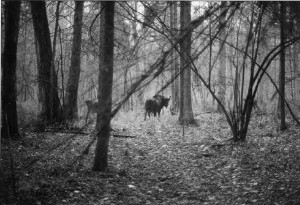
Narbutas relates an anecdote about some young bison that were transferred by Prussian gamekeepers in 1801 from Bialovieža to the Viskiautai (Wiskiauten) Forest in Lithuania Minor north of Karaliaucius (Koenigsberg) near the town of Krantas (Krantz). They were well looked after for several years, then one day they disappeared; two of them reappeared in Bialovieža, about 200 miles away, while the others ran off and became lost. Narbutas states that this story came from a reliable source.
World War I was disastrous for the wild bison of Bialovieža. In 1915 there were known to be 785 individuals, but by the war’s end in 1919 there were none to be found. Fortunately, 54 captive European bison remained in zoos, and it was from just 13 of these animals that a present-day population has been expanded through an international effort on the part of conservationists. There are now well over 3000 European bison on the continent, both free-ranging and captive. About 230 of the animals are in the Polish part of Bialovieža and still more in the part of the forest in Belarus.
There is a movement in modern ecology to go beyond mere conservation of what remains of natural ecosystems. Instead, ecologists are making attempts at ecosystem restoration by putting back species that had been lost due to human activities. In Lithuania, zoologists have taken up this challenge of modern ecology. Since 1969 they have been managing and studying captive and free-ranging herds which they have established at Pašiliai Forest located in the Panevežys District in central Lithuania. Starting with two specimens brought from a bison preserve near Moscow, the Lithuanian herd has been steadily increasing. It has been observed that after a period of time on their own the free-ranging bison become shy and wary, and have a tendency to avoid humans. Another herd is planned for an area 20 km. to the southeast of Marijampole near Žuvintas, a noted nature preserve. Through this restoration project Lithuania is, once again, a place where the noble stumbras does, indeed, roam.
 DRAUGAS NEWS Lithuanian World Wide News in English
DRAUGAS NEWS Lithuanian World Wide News in English
